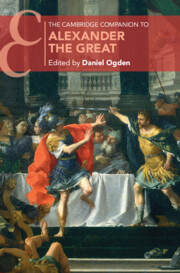Book contents
- The Cambridge Companion to Alexander the Great
- Cambridge Companions to the Ancient World
- The Cambridge Companion to Alexander the Great
- Copyright page
- Dedication
- Contents
- Figures
- Tables
- Maps
- Abbreviations
- Notes on Contributors
- Acknowledgements
- Introduction
- Part I Alexander’s Life and Career
- Part II Contexts
- Part III The Historical and Biographical Tradition
- Part IV The Ancient World’s Memory of Alexander
- 26 The Successors and the Image of Alexander
- 27 Alexander and The Roman Emperors
- 28 The Alexander Romance
- 29 Alexander in Jewish and Early Christian Literature
- 30 Alexander in Ancient Art
- Alexander’s Timeline 356–321 BC
- References
- Index
- Cambridge Companions to the Ancient World
29 - Alexander in Jewish and Early Christian Literature
from Part IV - The Ancient World’s Memory of Alexander
Published online by Cambridge University Press: 04 January 2024
- The Cambridge Companion to Alexander the Great
- Cambridge Companions to the Ancient World
- The Cambridge Companion to Alexander the Great
- Copyright page
- Dedication
- Contents
- Figures
- Tables
- Maps
- Abbreviations
- Notes on Contributors
- Acknowledgements
- Introduction
- Part I Alexander’s Life and Career
- Part II Contexts
- Part III The Historical and Biographical Tradition
- Part IV The Ancient World’s Memory of Alexander
- 26 The Successors and the Image of Alexander
- 27 Alexander and The Roman Emperors
- 28 The Alexander Romance
- 29 Alexander in Jewish and Early Christian Literature
- 30 Alexander in Ancient Art
- Alexander’s Timeline 356–321 BC
- References
- Index
- Cambridge Companions to the Ancient World
Summary
Macedonian conqueror, in both Jewish and Christian sources, was a composite and of complicated design. It was constantly created and recreated, using varied techniques and inspirations, which resulted in a number of disparate, fragmentary projections. The dominant features of these projections were selected according to the immediate need and agenda of the text in which the figure of Alexander appeared. There is a certain continuity between the development of Alexander stories and legends in the Jewish milieu and those of the Greek and Roman pagan traditions, but there are significant innovations as well. As for the Christian authors, as much as they were familiar with Classical writings on Alexander, they would also exploit the Jewish corpus of Alexander legends, some of which have no direct parallel in Greco-Roman pagan writings.
- Type
- Chapter
- Information
- The Cambridge Companion to Alexander the Great , pp. 471 - 487Publisher: Cambridge University PressPrint publication year: 2024

